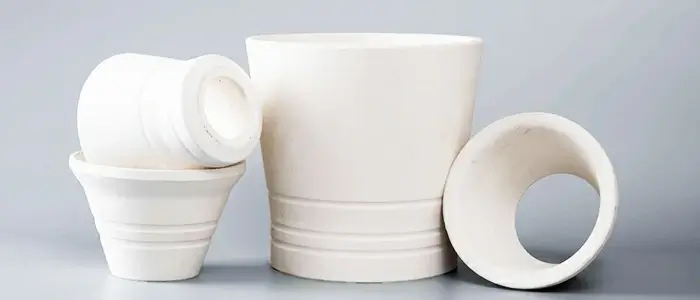In the world of precision investment casting, every detail matters. The Ceramic Pouring Cup is a perfect example. This deceptively simple component plays a critical role as the primary entry point for molten metal, directly influencing the quality, integrity, and success of a cast component.
What is a Ceramic Pouring Cup?
A Ceramic Pouring Cup is a funnel-shaped vessel made from advanced refractory ceramics. It is securely attached to the top of a pre-fired ceramic shell mold. During the casting process, it acts as a receiver, channeling molten metal from the furnace ladle into the mold’s intricate gating system and cavities.

Why is Pouring Cup a Critical Component?
Its function extends far beyond being a simple funnel. Its design and material are essential for achieving high-quality castings.
- Receives and Directs Molten Metal: It cleanly captures the stream of metal poured from the ladle, minimizing splashing and turbulence.
- Promotes Smooth Metal Flow: The cup’s geometry is designed to streamline the liquid metal, guiding it smoothly into the downsprue. This reduces air entrapment and prevents erosion of the mold interior.
- Slag Trapping: Impurities like slag and dross often sit on the surface of the molten metal. The pouring cup’s capacity allows these contaminants to float and remain within the cup, preventing them from entering the mold and causing defects in the final part.
- Feeding and Solidification: The reservoir of hotter metal within the cup cools and solidifies last. This provides a crucial source of liquid metal to feed shrinkage in the casting as it cools, resulting in a denser, stronger part free of voids.
- Ensures Complete Mold Filling: The height of the metal in the cup creates necessary pressure (metallostatic head), forcing the metal to rapidly fill even the most complex and thin-walled sections of the mold.
Advanced Materials for Extreme Conditions
These are not ordinary ceramics. They are engineered from premium refractory compounds to withstand extreme thermal shock and corrosive alloys.
-
Alumina (Al₂O₃): A widely used material offering an excellent balance of high strength, refractoriness, and thermal shock resistance.
-
Zirconia (ZrO₂): Employed for the most demanding applications. It offers superior resistance to erosion and reaction with highly active superalloys and titanium alloys.
-
Other Formulations: Materials like fused silica or aluminosilicate are also used for specific alloy types and cost requirements.
Specialized Types for Enhanced Quality
-
Open Pouring Cups: The standard, most common type.
-
Stopper-Head Cups: Feature a ceramic stopper. The cup is filled first, and the stopper is then lifted to initiate pouring. This allows for excellent control over the initial pour and superior slag trapping.
-
Cups with Integral Filters: Designed to hold a ceramic foam filter, providing an additional stage of filtration for ultra-clean metal.

Key Applications of Ceramic Pouring Cups
Ceramic Pouring Cups are indispensable in investment casting foundries producing high-value, mission-critical components for:
-
Aerospace: Turbine blades, engine components.
-
Medical: Orthopedic implants (hips, knees), surgical instruments.
-
Industrial Gas Turbines: Blades, vanes, and combustor parts.
-
Automotive: Turbocharger wheels, lightweight structural parts.
-
Defense and High-Tech: Components requiring superior metallurgical integrity.
The Process: How is Pouring Cup Used?
-
Shell Building: The cup is manually attached to the wax pattern cluster during the later stages of the ceramic shell building process.
-
Dewax & Firing: The entire shell, including the cup, is fired in a high-temperature oven. This process strengthens the ceramic and prepares it to receive molten metal.
-
Pouring: The fired shell is placed in a foundry flask. Molten metal is poured from a ladle directly into the Ceramic Pouring Cup, filling the mold.
Conclusion
The Ceramic Pouring Cup is a fundamental yet sophisticated element of investment casting. Its proper selection and use are vital for controlling the pour, improving metal quality, and ensuring the production of sound, reliable cast components. For engineers and procurement specialists specifying casting processes, understanding this component is key to achieving desired outcomes.

